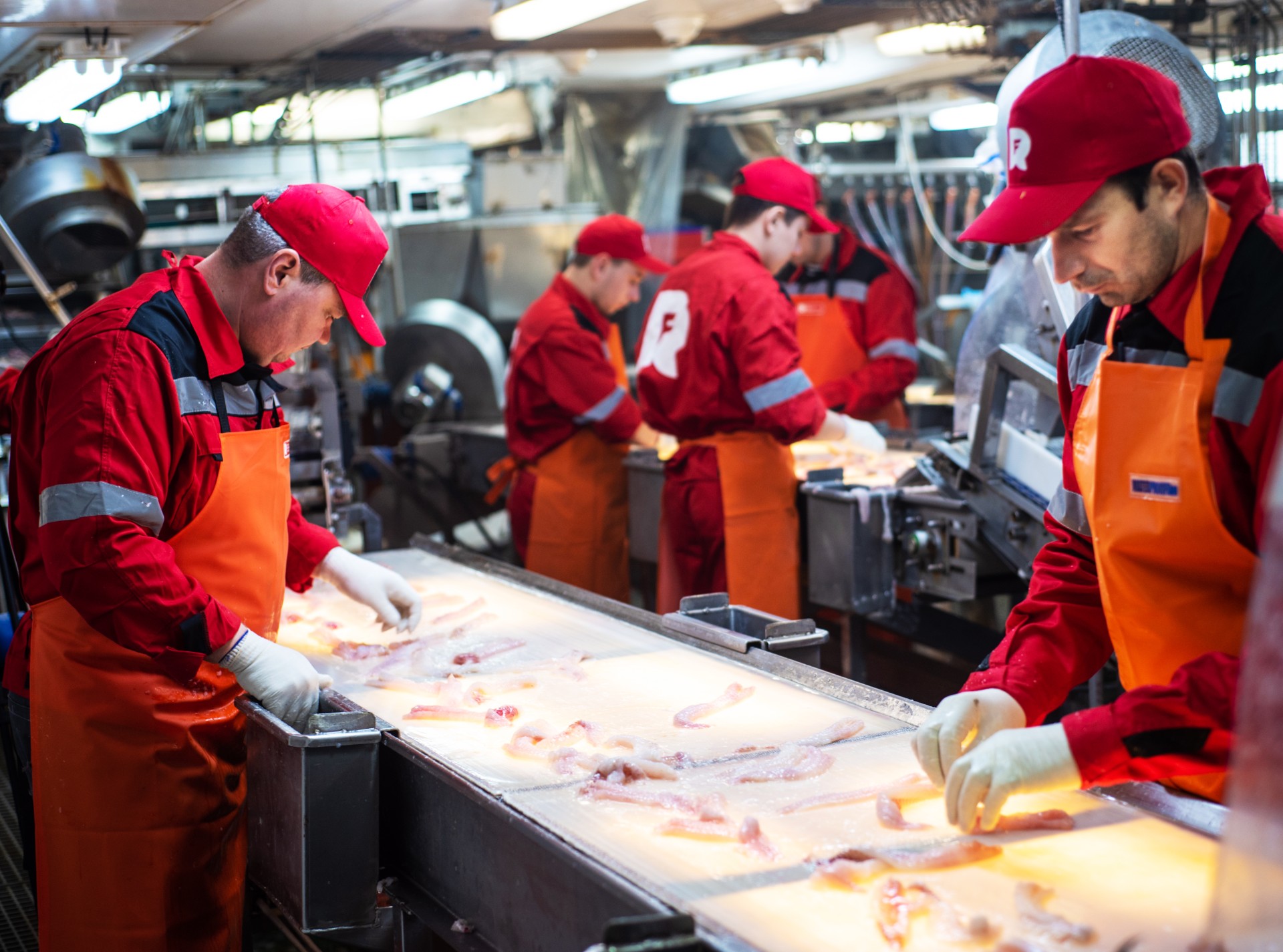Manufacturing processes
The fishing process begins with the trawl equipment (the main fishing gear), which is carried out by the crew under the guidance of the captain's assistant for catch. All the components of the trawl system are to be checked. The trawl and the trawl bag are checked for compliance with the Fishing Rules.
The fishing process is supervised by the captain who is the director of the vessel. He determines the fishing area and fishing tactics.
The trawling process includes:- search and definition of a fishing object;
- setting and introduction of the trawl;
- trawling until the trawl bag is full;
- hauling trawl;
- pouring the catch into receiving bunkers.
Acceptance of raw material into the working area begins with pouring the catch from the trawl bag into receiving bunkers. Raw fish is stored in storage containers until processing.
The entire catch is processed within a few hours from the moment of catch; mixing raw fish from different catches is not allowed.
Before accepting a new catch, the bunkers are thoroughly washed with seawater from the remnants of fish, chipped scales and mucus.
From the receiving bins, raw fish is moving to a belt conveyor, where it is sorted by species.
At the same time, it is washed. Then it is put to the sorting machine, where it is divided into three fractions. For Pollock fractions are the first (45 cm and more), the second (40-45 cm) and the third (35-40 cm). Fractions are sent to three storage bins and sequentially to the cutting process. Fish with visible physical and natural damage is sorted and sent to the production of fishmeal.
The raw material divided into fractions and accumulated in storage tanks for further processing (production of headless carcasses, fillets or minced fishmeat).
For the frozen uncut fish production, the raw fish, after sorting, is sent to the packing area.
In the production of headless carcasses, fillets and minced meat, the raw fish is sent to the cutting line after the sorting. It is preliminarily washed with water using a sprinkler at the exit from the storage bins. The first stage of filleting includes heading and removal of the viscera (caviar, milt, liver). At the second stage the carcass is cut into fillets to be unskinned and sent to the inspection (fillet lumen conveyor). After washing with disinfected sea water, the fillet passes through a device for excess moisture removing and is sent for packaging and weighing.
For surimi production fillets are crushed to a fraction of minced meat and repeatedly washed with clean cold water to obtain refined insoluble proteins. Purified, desalinated and disinfected sea water is used for washing. The surimi protein mass is fed to a centrifuge to remove excess moisture and then to packaging, weighing and freezing.
Minced meat is produced on a minced meat machine. After processing it is sent for packaging in a mold block. For headless fish production, fish carcass after removing the entrails is sent to washing and packaging in baking sheets or a block of forms ready for freezing.
By a separate conveyor after the fish-cutting machine, all entrails are sent to the line for sorting and processing waste (separation of caviar, milt, liver). Heads are immediately sent to the production of fish meal. Heads can also be assembled and served as a product for Asian markets.
Inspection of headed carcasses and whole round fish is carried out on a separate line (conveyor) leading to the packaging area.
Fillets are inspected on lighted inspection conveyors.
Each fillet is turned upside down, inspected and probed for bones, parasites, skin debris, bruising, etc. At the same time, fillets of irregular shape are rejected.
Packing is carried out in baking trays or in block forms made of aluminum or stainless steel.
Packing of surimi, fillets and minced meat, as well as caviar, milt, liver is carried out on a specially designated table. Block-forms and baking trays with packaged products are sent on a conveyor for freezing.
Freezing of products is carried out until the temperature in the thickness of the fish meat is not higher than minus 18 degrees Celsius.
After the freezing trays or block-forms with fish products are sent along a conveyor to the packaging area. Between the freezing and packaging section the frozen products are removed (knocked out) from trays or block forms.
Frozen blocks of products are passed through a metal detector to detect contamination before packing.
To prevent moisture loss and further to preserve the quality of frozen products, glazing of frozen blocks with fish is performed using fresh water.
Frozen blocks are packed in paper bags with a polypropylene layer (sandwich bags) or cardboard boxes.
The container is tied on a strapping machine with polypropylene tape. Before packaging products, containers are prepared and marked in advance with a thermal label.
Marking includes mandatory information in Russian in accordance with the requirements of Russian regulatory documents, technical regulations, EU directives, GOST, etc. At the same information in foreign languages to be agreed with the buyers is also presented.
Finished products are stored in the holds of trawlers at temperatures of minus 18 degrees Celsius and below. Frozen products are separated by species, gradation or by separate batches in the holding area.
Storage of fishmeal is carried out in a ventilated flour hold, at a temperature not exceeding 20 degrees Celsius with a relative humidity of 60-80%.
In order to be delivered to the shore the products are loaded onto transport refrigerators. It ensures transportation with strict observance of storage conditions.



























































































